February 2023 Regulatory Update
The New York State Governor signed a bill into law to ban mercury and several mercury-containing compounds in cosmetics and personal care products. The law will take effect starting 1 June 2023.
View Story Read MoreOn 23 December 2022, the New York State Governor signed bill (A8630A) regarding mercury into law. The bill bans mercury and mercury-containing compounds in cosmetics and personal care products. The bill will take effect starting 1 June 2023.
“Cosmetic product” is defined as any article intended to be rubbed, sprinkled, or sprayed on, introduced into, or otherwise applied to the human body or any part thereof for beautifying, promoting attractiveness or altering the appearance and intended for use as a component of any such article. It shall not include any personal care products.
“Personal care product” is defined as any product intended for cleaning or cleansing any part of the body, such as the skin and hair including but not limited to, hair shampoo, hair conditioner, soap, bath gels and other bath products.
“Mercury” includes elemental mercury Hg, mercuric iodide, mercury oxide, mercurous chloride, ethyl mercury, phenyl mercuric salts, ammoniated mercury, amide chloride of mercury, mercury sulfide or cinnabaris, or mercury iodide.
Those selling these products in New York State should compare the ingredients against the banned chemicals in advance of the law’s effective date so appropriate action can be determined.
California has added three substances to its list of chemicals known to cause cancer. The warning requirement will take effect on 27 January 2024.
View Story Read MoreOn 27 January 2023, the California Office of Environmental Health Hazard Assessment (OEHHA) provided an updated list of substances on California’s Proposition 65 list. Three extra substances have been added as cancer-causing chemicals. The warning requirement for significant exposures to these chemicals will take effect on 27 January 2024.
Under Proposition 65, companies doing business in California should provide a clear and reasonable warning before knowingly and intentionally exposing anyone to these chemicals by the aforementioned effective date.
The details of the three chemical substances are listed in the below table.
| Substance | CAS no. | Type of toxicity | Common uses |
| 1-Bromo-3-chloropropane | 109-70-6 | Cancer, DNA damage | Gasoline production, catalyst in pharmaceuticals |
| 1-Butyl glycidyl ether | 2426-08-6 | Cancer | Adhesives, paint, sealants |
| Glycidyl methacrylate | 106-91-2 | Cancer | Polymer coatings, finishes, adhesives, plastics, elastomers |
The Modernization of Cosmetic Regulation Act of 2022 (MoCRA) has been signed into law as part of the inclusion of the Consolidated Appropriation Act by President Biden on 29 December 2022. This is the most significant update of the US Federal Food, Drug and Cosmetic Act (FDCA) since its introduction in 1938.
View Story Read MoreOn 29 December 2022, President Biden signed the Consolidated Appropriation Act, including the Modernization of Cosmetic Regulation Act of 2022 (MoCRA) as part of the context, into law. MoCRA is the first major update to the cosmetic regulations in the United States since the introduction of the Federal Food, Drug and Cosmetic Act (FDCA) in 1938.
MoCRA amends Chapter VI of the FDCA to include new provisions for cosmetic products. It enhances the Food and Drug Administration (FDA) regulatory jurisdiction and enforcement of cosmetics. A wide range of personal care and beauty products are covered by MoCRA including but not limited to hair and hair removal products, makeup, nail products, body lotions, and tanning products.
“Cosmetic product” is defined as any article intended to be rubbed, poured, sprinkled, or sprayed on, introduced into, or otherwise applied to the human body or any part thereof for cleansing, beautifying, promoting attractiveness or altering the appearance and intended for use as a component of any such article. It shall not include soap.
MoCRA includes a few new important provisions:
- Registration with the FDA is required for cosmetic manufacturers by 29 December 2023.
- All cosmetic products distributed in the United States must be listed with the FDA by 29 December 2023.
- Manufacturers need to submit a report to FDA within 15 days in the case of a “serious adverse event."
- The FDA has the authority to recall a cosmetic product if it is misbranded or adulterated. The manufacturer can voluntarily recall first.
- Manufacturers will need to maintain all safety substantiation records of cosmetics.
- The FDA will work on regulations or requirements on perfluoroalkyl and polyfluoroalkyl substances (PFAS) and talc-containing cosmetics and also on good manufacturing practice (GMP) measures.
In the US, when hazards are identified in consumer products, they will be recalled and published in the Consumer Product Safety Commission (CPSC) Recent Recalls on the CPSC website, which is updated daily. The US recalls from 01 January 2023 to 31 January 2023 are summarized below:
View Story Read More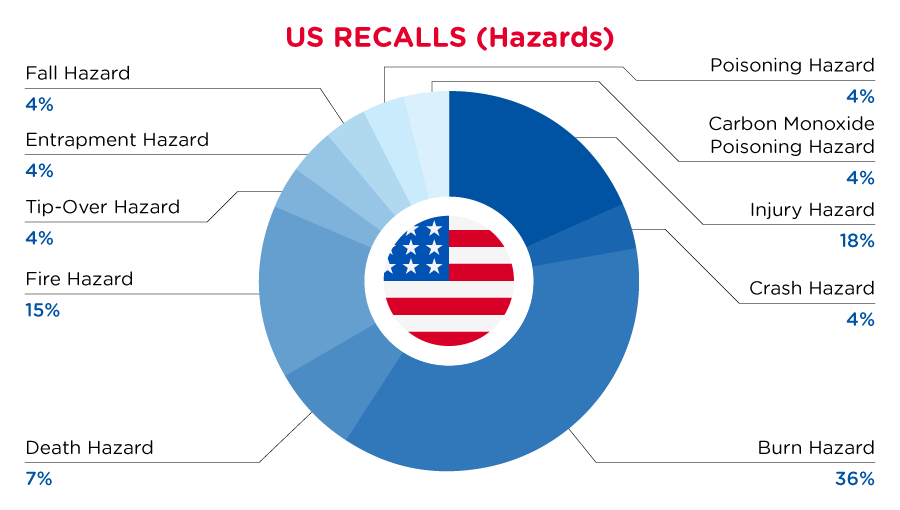
| Hazards | Frequency |
| Injury Hazard | 5 |
| Crash Hazard | 1 |
| Burn Hazard | 10 |
| Death Hazard | 2 |
| Fire Hazard | 4 |
| Tip-Over Hazard | 1 |
| Entrapment Hazard | 1 |
| Fall Hazard | 1 |
| Poisoning Hazard | 1 |
| Carbon Monoxide Poisoning Hazard | 1 |
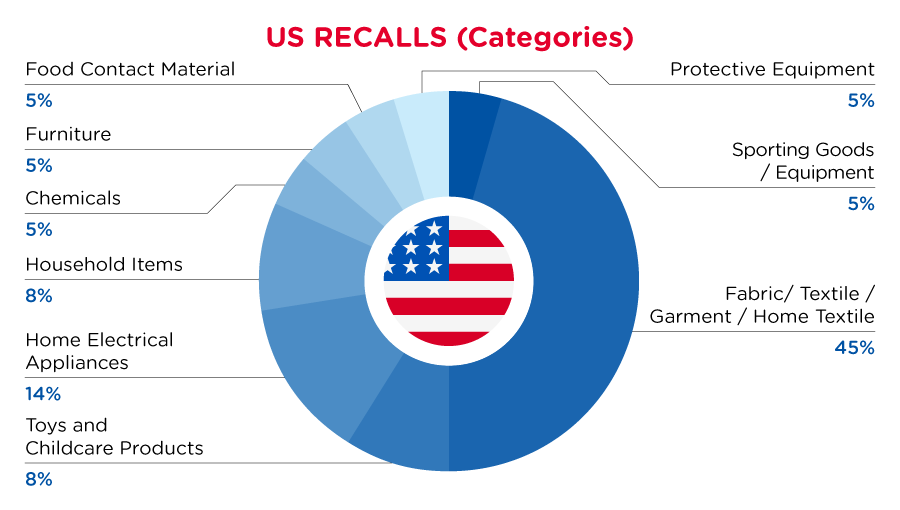
| Product Categories | Frequency |
| Sporting Goods / Equipment | 1 |
| Fabric / Textile / Garment / Home Textile | 10 |
| Toys and Childcare Products | 2 |
| Home Electrical Appliances | 3 |
| Household Items | 2 |
| Chemicals | 1 |
| Furniture | 1 |
| Food Contact Material | 1 |
| Protective Equipment | 1 |
For a complete list click here
In Canada, when hazards are identified in consumer products, they will be recalled and published in the Recalls and Safety Alerts Database on the Health Canada website, which is updated daily. The Canada recalls from 01 January 2023 to 31 January 2023 are summarized below:
View Story Read More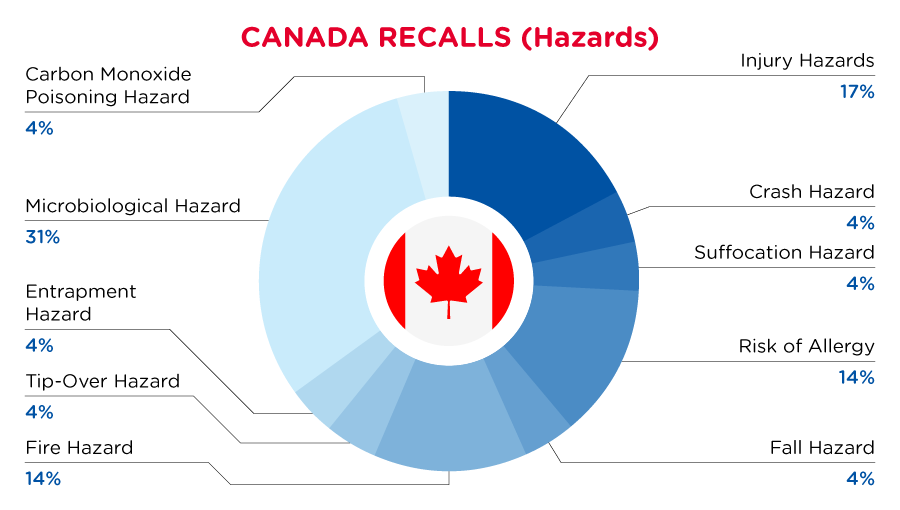
| Hazards | Frequency |
| Injury Hazard | 4 |
| Crash Hazard | 1 |
| Suffocation Hazard | 1 |
| Risk of Allergy | 3 |
| Fall Hazard | 1 |
| Fire Hazard | 3 |
| Tip-Over Hazard | 1 |
| Entrapment Hazard | 1 |
| Microbiological Hazard | 7 |
| Carbon Monoxide Poisoning Hazard | 1 |
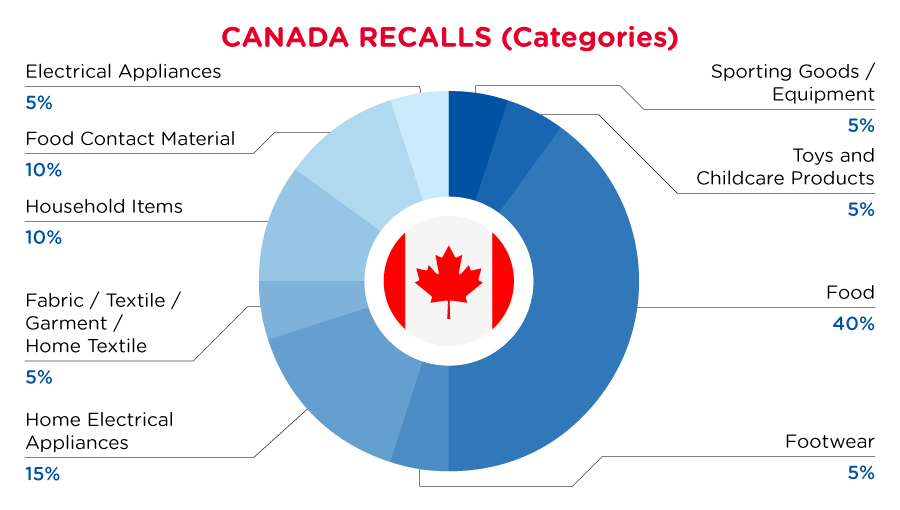
| Product Categories | Frequency |
| Sporting Goods / Equipment | 1 |
| Toys and Childcare Products | 1 |
| Food | 8 |
| Footwear | 1 |
| Home Electrical Appliances | 3 |
| Fabric / Textile / Garment / Home Textile | 1 |
| Household Items | 2 |
| Food Contact Material | 2 |
| Electrical Appliances | 1 |
For a complete list click here
In Australia, when hazards are identified in consumer products, they will be recalled and published in the Recalls and Safety Alerts Database on the Australian Competition & Consumer Commission website, which is updated daily. The Australia recalls from 01 January 2023 to 31 January 2023 are summarized below:
View Story Read More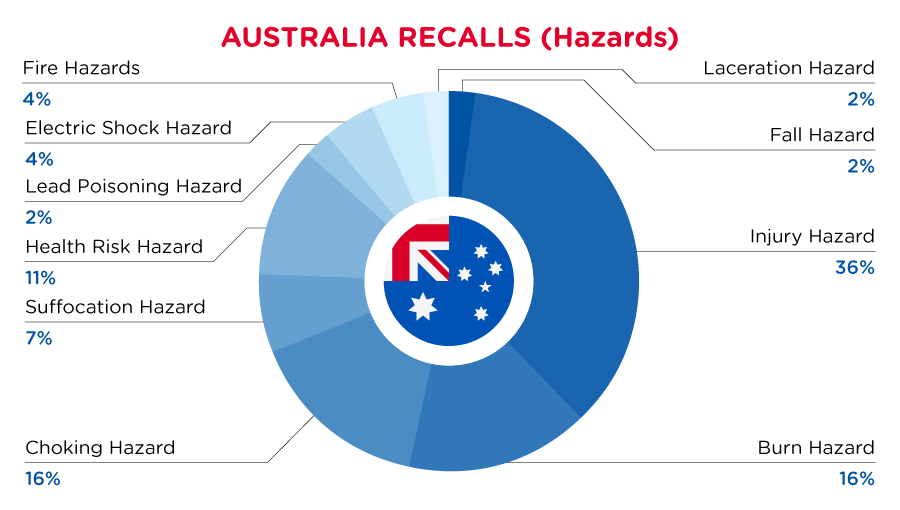
| Hazards | Frequency |
| Fall Hazard | 1 |
| Injury Hazard | 16 |
| Burn Hazard | 7 |
| Choking Hazard | 7 |
| Suffocation Hazard | 3 |
| Health Risk Hazard | 5 |
| Lead Poisoning Hazard | 1 |
| Electric Shock Hazard | 2 |
| Fire Hazard | 2 |
| Laceration Hazard | 1 |
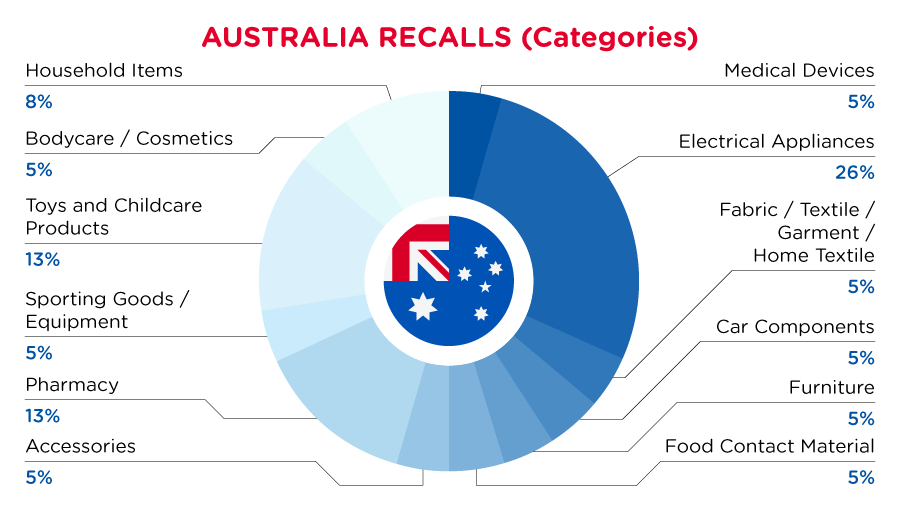
| Product Categories | Frequency |
| Medical Devices | 1 |
| Electrical Appliances | 6 |
| Fabric / Textile / Garment / Home Textile | 1 |
| Car Components | 1 |
| Furniture | 1 |
| Food Contact Material | 1 |
| Accessories | 1 |
| Pharmacy | 3 |
| Sporting Goods / Equipment | 1 |
| Toys and Childcare Products | 3 |
| Bodycare / Cosmetics | 1 |
| Household Items | 2 |
For a complete list click here
The UK government conducted a consultation of Packaging Producer responsibility in 2019 and 2021 and confirmed intention to proceed with a requirement to label packaging to indicate if the packaging is recyclable or not.
The labeling effective date will be on 31 March 2026 for all materials (except plastic films and flexible packaging) and 31 March 2027 for plastic films and flexible packaging.
In accordance with the newly published Labeling Guide for Extended Producer Responsibility (EPR) in the UK, all primary and shipment packaging will need to be labelled as “recycle” or “do not cycle,” along with the accompanying logo. This will relay to an individual or entity when they dispose of packaging, what the clear instruction is as to how to proceed.
The requirement to label packaging will be introduced as a part of a new UK wide packaging and packaging waste statutory instrument (SI) which is expected to come later this year.
Key information
- The SI will set out the key labeling requirements, including the requirement to assess packaging to determine recyclability and minimum size requirements.
- Labeling guidance will be published to help businesses adopt the requirements. This will include advice regarding the use of color, labeling of multi-material packaging and the inclusion of additional information on where to recycle and where there are alternative collection methods, such as taking to a store.
Brand owners and importers are responsible to label the packaging. Distributors will be required to provide small businesses with information on the recyclability of the packaging they supply. Some flexibility in how they provide recycling information will be provided to users of this packaging.
The labeling effective date will be on 31 March 2026 for all materials (except plastic films and flexible packaging) and 31 March 2027 for plastic films and flexible packaging.
The European Chemical Agency added nine new SVHCs to the Candidate List on 17 January 2023 for a total of 233 entries.
View Story Read MoreOn 17 January 2023, the European Chemical Agency (ECHA) launched the 28th update of the Registration, Evaluation, Authorisation and Restriction of Chemicals (REACH) candidate list. Nine new Substances of Very High Concern (SVHC) were added due to their hazardous properties. These substances are mainly used, for example, in flame retardants, paints and coatings, inks and toners, coating products, plasticisers and in the manufacture of pulp and paper. This brings the total to 233 entries of SVHC with immediate effect.
The details of the new SVHC substances are listed as below:
| Name | CAS Number | Reason for Inclusion | Potential Usage |
| 1,1'-[ethane-1,2-diylbisoxy]bis[2,4,6-tribromobenzene] | 37853-59-1 | Very persistent and very bioaccumulative (REACH Article 57 e) | While the substance itself is not registered under REACH, identification as an SVHC can be seen as a measure to avoid future regrettable substitution. |
| 2,2',6,6'-tetrabromo-4,4'-isopropylidenediphenol | 79-94-7 | Carcinogenic (Article 57 a) | As a reactive flame retardant and as an additive flame retardant in the manufacture of polymer resins, in products such as epoxy coated circuit boards, printed circuit boards, paper and textiles. |
| 4,4'-sulphonyldiphenol | 80-09-1 | Toxic for reproduction (Article 57 c); Endocrine disrupting properties (Article 57 f – environment); Endocrine disrupting properties (Article 57 f – human health) | In the manufacture of pulp, paper and paper products, textiles, leather or fur and chemicals. |
| Barium diboron tetraoxide | 13701-59-2 | Toxic for reproduction (Article 57 c) | In paints and coatings. |
| Bis(2-ethylhexyl) tetrabromophthalate covering any of the individual isomers and/or combinations thereof | / | Very persistent and very bioaccumulative (Article 57 e) | As a flame retardant and as a plasticizer for flexible polyvinylchloride and for use in wire and cable insulation, film and sheeting, carpet backing, coated fabrics, wall coverings and adhesives. |
| Isobutyl 4-hydroxybenzoate | 4247-02-3 | Endocrine disrupting properties (Article 57 f – human health) | In the manufacture of substances and in the following products: coating products, fillers, putties, plasters, modelling clay and inks and toners. |
| Melamine | 108-78-1 | Equivalent level of concern having probable serious effects to human health (Article 57 f – human health); Equivalent level of concern having probable serious effects to the environment (Article 57 f – environment) | In polymers and resins, coating products, adhesives and sealants, leather treatment products, laboratory chemicals. |
| Perfluoroheptanoic acid and its salts | / | Toxic for reproduction (Article 57 c); Persistent, bioaccumulative and toxic (Article 57 d); Very persistent and very bioaccumulative (Article 57 e); Equivalent level of concern having probable serious effects to human health (Article 57 f – human health); Equivalent level of concern having probable serious effects to the environment (Article 57 f – environment) | While the substance itself is not registered under REACH, identification as an SVHC can be seen as a measure to avoid future regrettable substitution. |
| reaction mass of 2,2,3,3,5,5,6,6-octafluoro-4-(1,1,1,2,3,3,3-heptafluoropropan-2-yl)morpholine and 2,2,3,3,5,5,6,6-octafluoro-4-(heptafluoropropyl)morpholine | / | Very persistent and very bioaccumulative (Article 57 e) | Used in articles, by professional workers (widespread uses), in formulation or re-packing, at industrial sites and in manufacturing. |
In Europe, when hazards are identified in non-food consumer products, the products will be recalled and published in the Safety Gate system, which is updated weekly. The European recalls from 01 January 2023 to 31 January 2023 are summarized below:
View Story Read More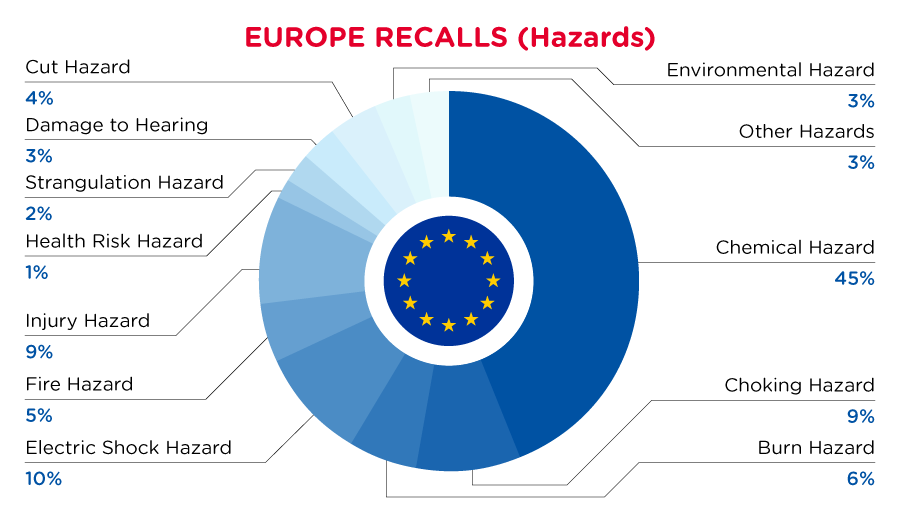
| Hazards | Frequency |
| Chemical Hazard | 97 |
| Choking Hazard | 20 |
| Burn Hazard | 13 |
| Electric Shock Hazard | 21 |
| Fire Hazard | 11 |
| Injury Hazard | 20 |
| Health Risk Hazard | 4 |
| Strangulation Hazard | 5 |
| Damage to Hearing | 7 |
| Cut Hazard | 9 |
| Environmental Hazard | 7 |
| Other Hazards* | 7 |
*Other Hazards include Aspiration Hazard, Suffocation Hazard, Entrapment Hazard, Damage to Sight and Microbiological Hazard with a frequency of less than 3.
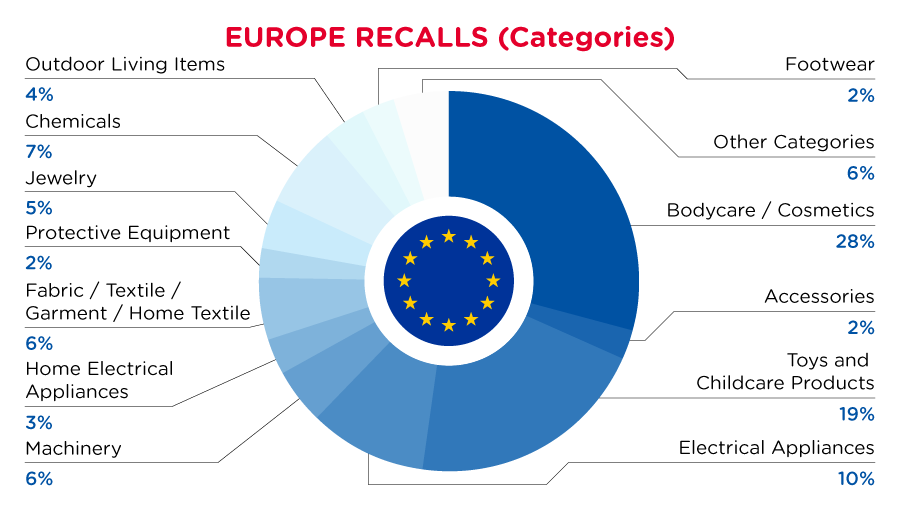
| Product Categories | Frequency |
| Bodycare / Cosmetics | 56 |
| Accessories | 5 |
| Toys and Childcare Products | 39 |
| Electrical Appliances | 19 |
| Machinery | 9 |
| Home Electrical Appliances | 6 |
| Fabric / Textile / Garment / Home Textile | 10 |
| Protective Equipment | 5 |
| Jewelry | 8 |
| Chemicals | 13 |
| Outdoor Living Items | 7 |
| Footwear | 5 |
| Other Categories* | 9 |
*Other Categories include Furniture, Construction Products, Computer / Audio / Video / Other Electronics & Accessories, Sporting Goods / Equipment and Household Items with a frequency of less than 5.
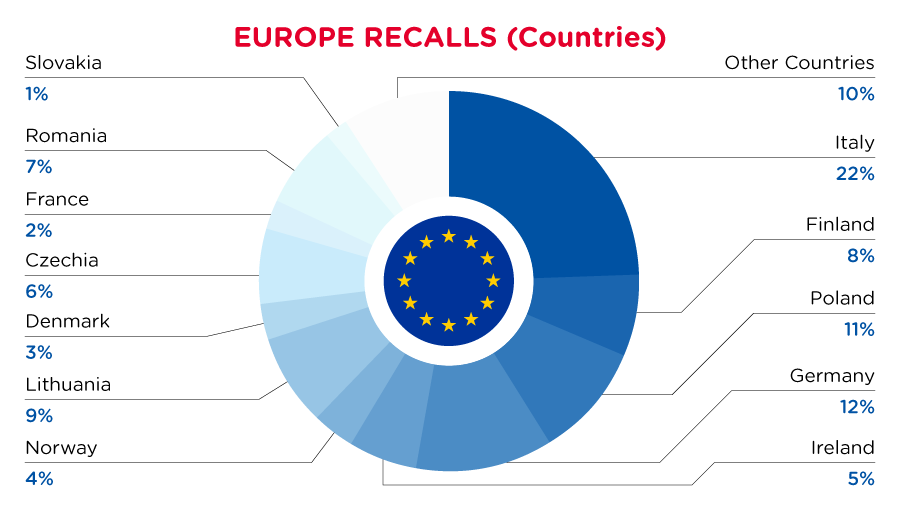
| Notifying Country | Frequency |
| Italy | 47 |
| Finland | 13 |
| Poland | 19 |
| Germany | 22 |
| Ireland | 11 |
| Norway | 7 |
| Lithuania | 15 |
| Denmark | 6 |
| Czechia | 12 |
| France | 5 |
| Romania | 13 |
| Slovakia | 4 |
| Other Countries* | 17 |
*Other Countries include Sweden, Austria, Belgium, Slovenia, Cyprus, Iceland, Hungary, Latvia, Estonia and Luxembourg with a frequency of less than 4.
For a complete list click here
Standard GB 31241-2022 for Lithium- ion cells/batteries used in portable electronic equipment was published by the China Standardization Administration (SAC) and the China's Ministry of Information and Industry Technology (MIIT) as a revision for GB 31241-2014 on 29 December 2022; it will enter into force on 1 January 2024.
View Story Read MoreThe lithium-ion cells or batteries used in the following portable electronic equipment product categories fall into the GB31241-2022 scope: portable office products, portable telecommunication products, portable audio/video products and other portable products like Global Positioning System (GPS) devices, electric books, power banks, etc.
This standard focuses on the basic safety requirements to protect people from personal injury, property damage and other damage. Performance and functional characteristics of portable electronic equipment containing these cells/batteries are not covered.
Leakage, fire, explosion, and overheating hazards were considered and taken as assessment criteria for safety requirements. Tests methods for intended use, reasonably foreseeable misuse and fault conditions were also given in this standard as below:
- Electrical safety tests for cell
- Environmental safety tests for cell
- Environmental safety tests for battery
- Electrical safety tests for battery
- Safety requirements of battery protective circuits
- Safety requirements of system protective circuits
- Consistency requirements
Through this standard, so that designers can understand the basic principles for designing cells and batteries, the following criteria are to be considered:
- Select materials with high safety performance, and try to avoid using materials that are prone to thermal runaway
- Involve protective devices to reduce or eliminate the possibility of danger
- Take measures to identify and explain potential hazards
The Chinese Ministry of Industry and Information Technology has issued a new industry standard of Woven Capes (FZ/T 81024-2022). It was included in China’s No. 10 announcement of approved industry standards in 2022 and became effective on 1 October 2022.
View Story Read MoreStandard FZ/T 81024-2022 for woven capes is applicable for ages greater than 36 months. This new industry standard was issued and included in China’s No. 10 announcement of approved industry standards in 2022. In accordance with this standard, a cape is defined as a spacious sleeveless coat that wraps around the shoulders and arms of user.
Requirements: Products must comply with the labeling requirements and the technical requirements stated in this standard, including but not limited to:
- Chemical requirements (Formaldehyde, Azo dyes)
- Fiber content
- pH value
- Odor
- Dimensional stability to washing, to drycleaning
- Appearance quality
- Colorfastness (to washing, to drycleaning, to water, to perspiration, to rubbing, to light)
- Pilling resistance
- Appearance after washing, after drycleaning
Children’s products (aged >36 months to 14 years old) shall also comply with the requirements in GB 31701 standard covering infant and children’s textile products.
This standard became effective on 1 October 2022.
In China, when hazards are identified in consumer products, they will be recalled and published in the SAMR Defective Product Administrative Centre, which is updated daily. The China recalls from 01 January 2023 to 31 January 2023 are summarized below:
View Story Read More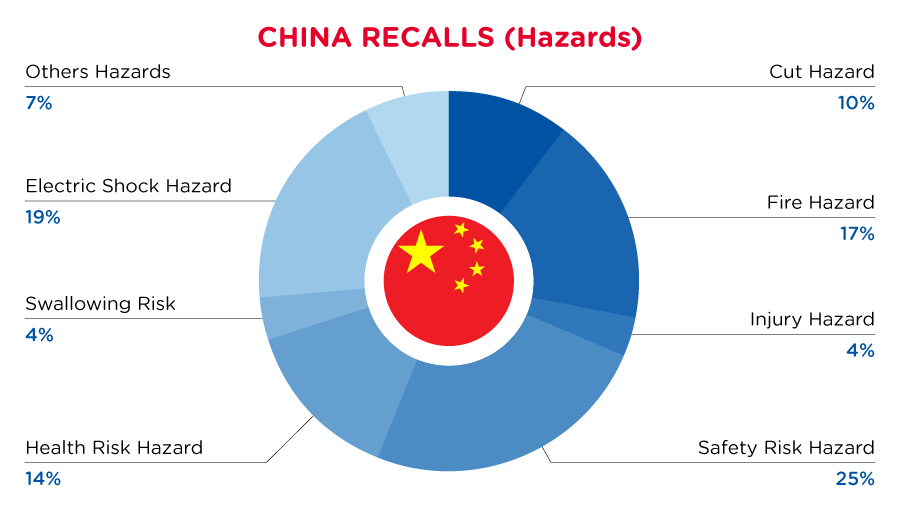
| Hazards | Frequency |
| Cut Hazard | 6 |
| Fire Hazard | 10 |
| Injury Hazard | 2 |
| Safety Risk Hazard | 14 |
| Health Risk Hazard | 8 |
| Swallowing Risk | 2 |
| Electric Shock Hazard | 11 |
| Other Hazards* | 4 |
*Other Hazards include Burn Hazard, Puncture Hazard, Carbon Monoxide Poisoning Hazard and Suffocation Hazard with a frequency of less than 2.

| Product Categories | Frequency |
| Stationery | 5 |
| Home Electrical Appliances | 11 |
| Electrical Appliances | 5 |
| Protective Equipment | 3 |
| Construction Products | 1 |
| Food Contact Material | 4 |
| Household Items | 2 |
| Fabric / Textile / Garment / Home Textile | 3 |
| Sporting Goods / Equipment | 1 |
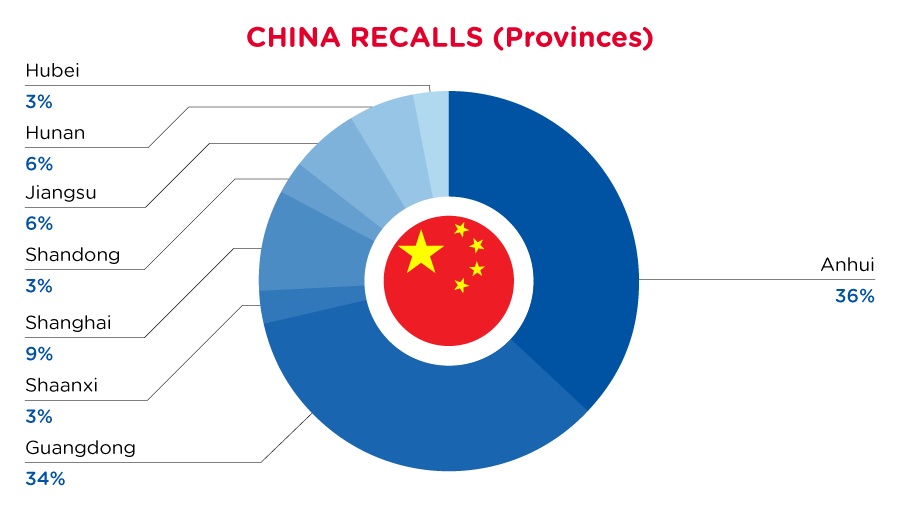
| Provinces | Frequency |
| Anhui | 13 |
| Guangdong | 12 |
| Shaanxi | 1 |
| Shanghai | 3 |
| Shandong | 1 |
| Jiangsu | 2 |
| Hunan | 2 |
| Hubei | 1 |
For a complete list click here

